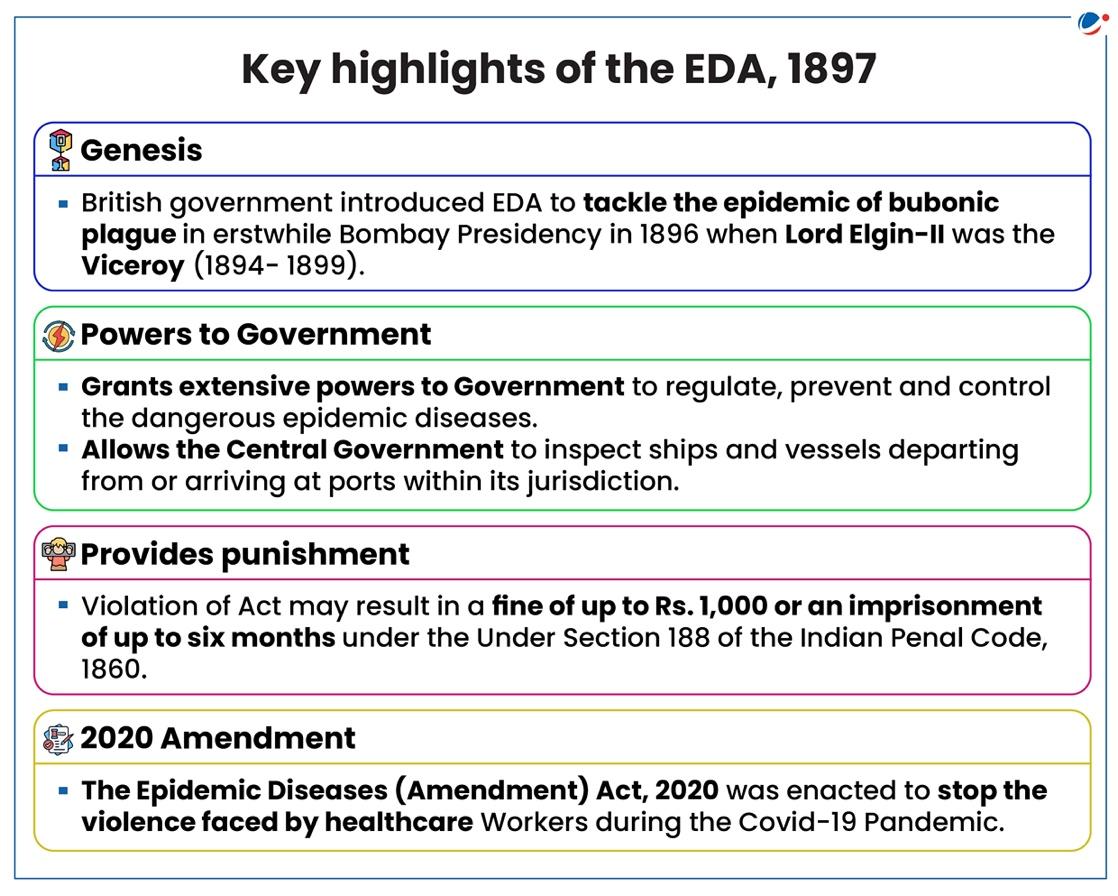Why in the News?
Recently, the 22nd Law Commission of India (LCI) submitted a report titled “A Comprehensive Review of the Epidemic Diseases Act, 1897" to the Government of India.
About the report
- The report acknowledges limitations in the legal framework relating to health were prominently visible during the management of COVID-19 pandemic when Disaster Management Act, 2005 was invoked to impose lockdown.
- In 2020, Parliament amended the Epidemic Diseases Act (EDA), 1897. However, even the amendments could not address gaps in the Act.
- The LCI suo motu undertook examination of EDA, 1897 and International Health Regulation (IHR), 2005.
- It recommended to either amend the existing law or bring a new comprehensive legislation to address existing gaps.

Key issues in the EDA, 1897 as highlighted by the LCI
- Outdated colonial-era law: The vast power given to the government has the potential of abuse. Also, Over the years, new variants of communicable diseases have emerged posing fresh challenges to the healthcare system.
- Lack of definition: Does not define an 'epidemic' or an 'infectious' disease, and does not differentiate between an 'outbreak', 'epidemic' and 'pandemic'.
- Management of Epidemic: The Act lacks specific guidelines for effective disease surveillance, quarantine process, ensuring availability of drugs and vaccines, and disposal of Infectious waste and Corpses.
- Governance issues:
- Lack of decentralisation: The Act does not provide statutory power to local governments to regulate epidemic diseases.
- Lack of demarcation of power: ‘Prevention of infection or Contagious diseases’ is in the Concurrent list both Centre and States have the power to frame appropriate law on these subjects.
- The EDA, does not specify authority will take precedence in case of disagreements between the States and the Centre.
- Uncoordinated response: Lack of enforcement mechanism as per the nature and gravity of the epidemic diseases hinders the prevention and controlling and leads to uncoordinated response.
- Inadequate punishment for violation
International Health Regulations (IHR)
|

Key highlights of the Comprehensive law proposed by the LCI
- Define terminologies:
- Stages of the diseases (refer to the infographics) should be defined.
- Difference between 'quarantine' and 'isolation' should be clarified.
- The Epidemic diseases Bill 2023 appropriately defines both the term.
- Incorporate the terms ‘physical distancing’ instead of ‘social distancing’ to contain the spread by restricting people’s movement.
- Decentralisation and demarcation of power:
- Prevention and management: This power should lie with State government since ‘public health and ‘sanitation’ is a State subject under the 7th Schedule of the Constitution.
- Outbreak happens in State: State may empower the district or local authority to take measures to effectively prevent, control and manage the epidemic.
- Interstate-spread of epidemic/pandemic: Central government should direct the state government/district authorities to implement measure for managing the diseases.
- Extreme threat from infectious diseases: Central government should itself take measures and or should empower some other Central Agency for managing the diseases.
- Frame an epidemic plan: The Central government should prepare the epidemic plan in collaboration with other stakeholders) which should be revised periodically.
- State government should be empowered to make respective state regulations.
- Guidelines for Quarantine and isolation: The proposed guidelines should be in consonance with the
- Indian Port Health Rules, 1955 (deals with the isolation of infected ships) and
- Aircraft (Public Health) Rules 1954 (deals with the isolation of infected persons in an aircraft).
- Other recommendations
- Enhanced penalty for violation and give statutory recognition under the EDA.
- Separate guidelines for Safe disposal of infectious waste which aligns with Bio-Medical Waste Management Rules, 2016.
- Devise regulation for controlling, and regulating the availabilities of essential medicines to combat their shortages during peak demand.
- Identify nodal authorities responsible for developing vaccines and other necessary drugs.
Conclusion
In this highly globalized and interconnected world, future outbreaks of epidemics are a real possibility. Further, given that the right to health is a fundamental right implicit in Article 21 of the Constitution and the State is duty-bound to ensure the same to the citizens, it becomes imperative to revisit and strengthen the law in order to effectively tackle any such future health emergency.



